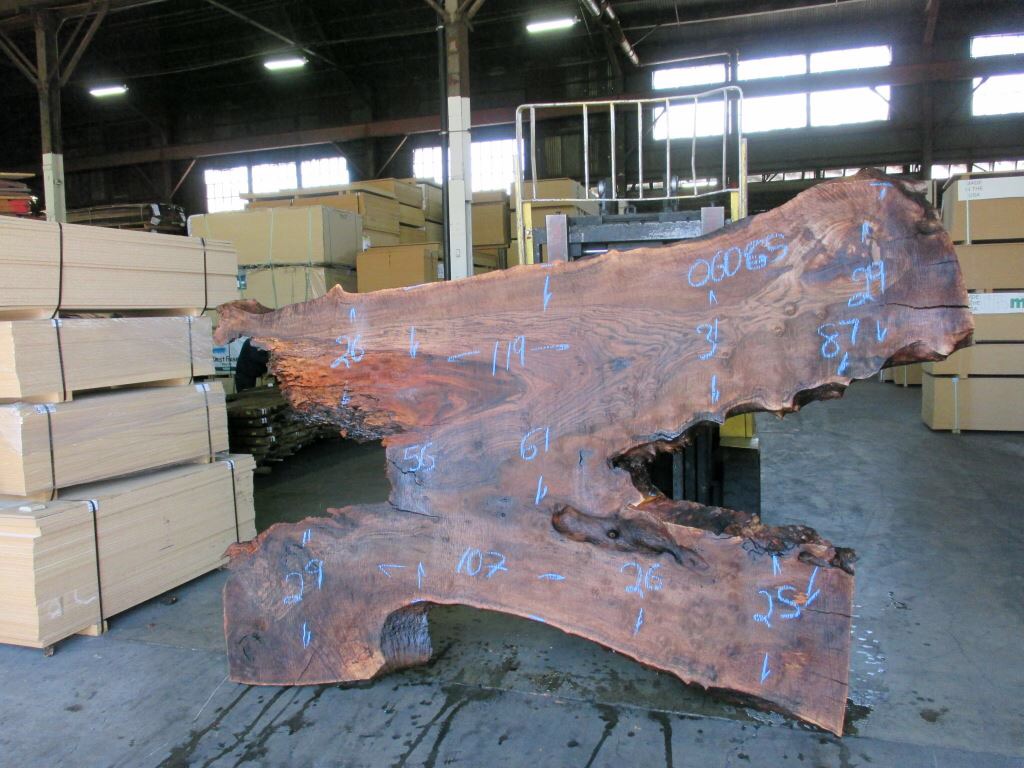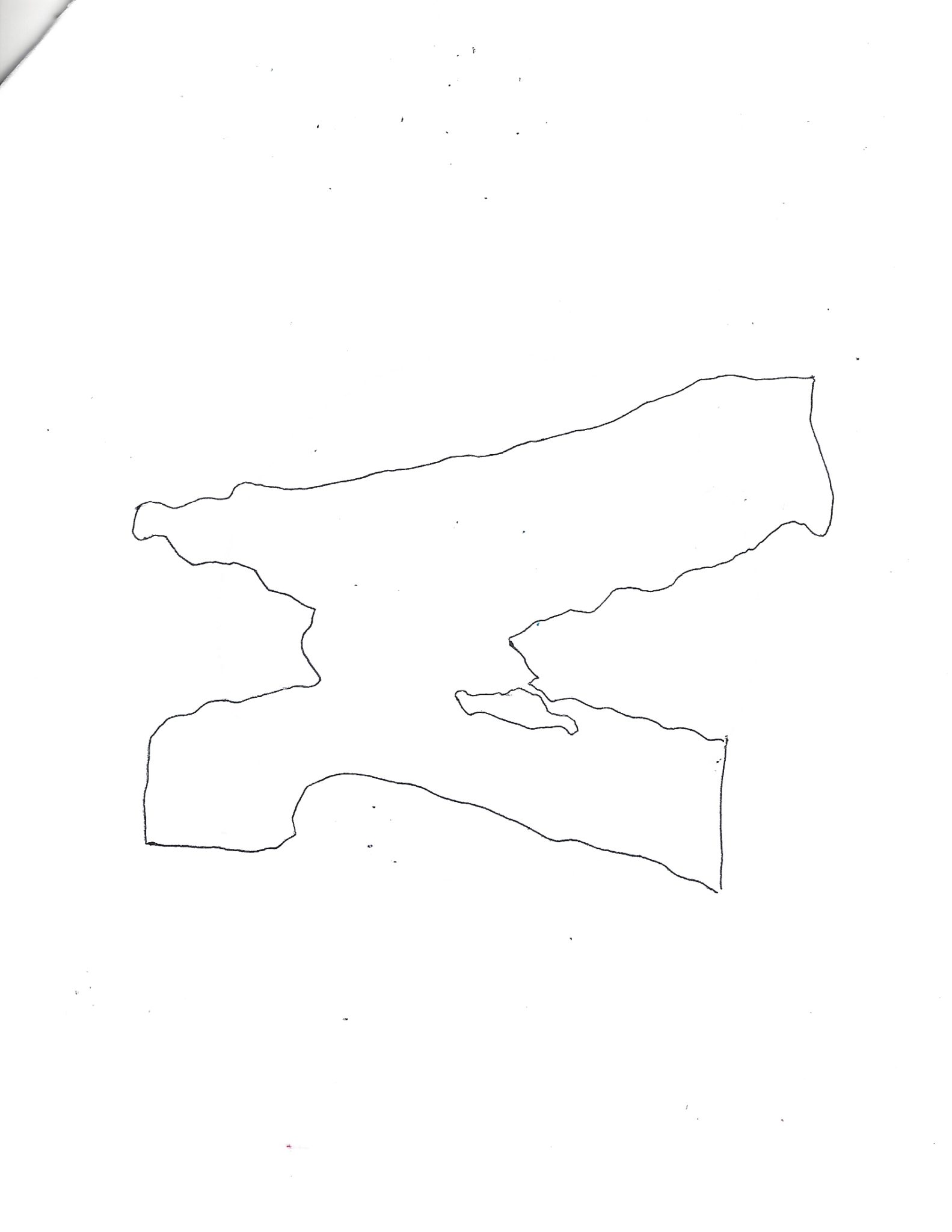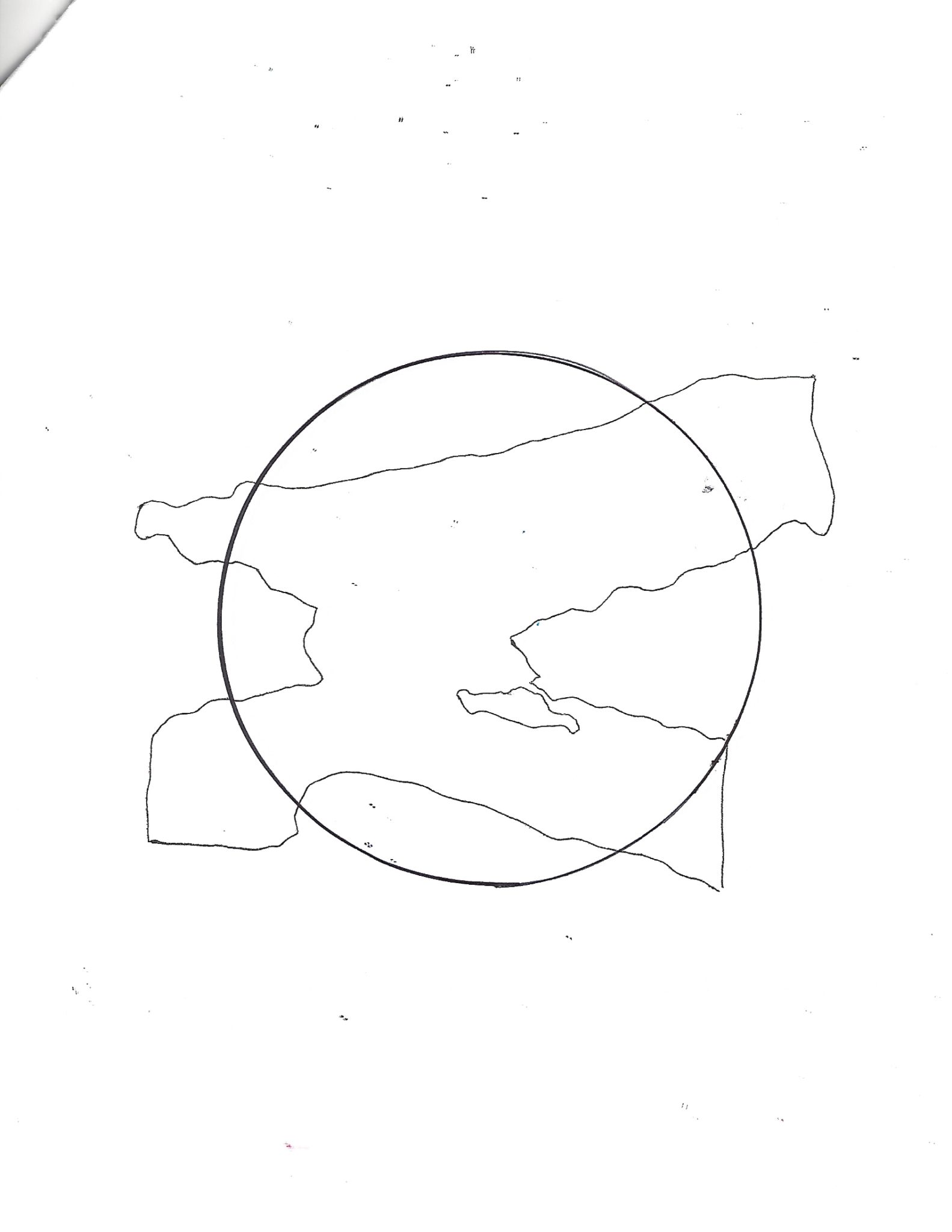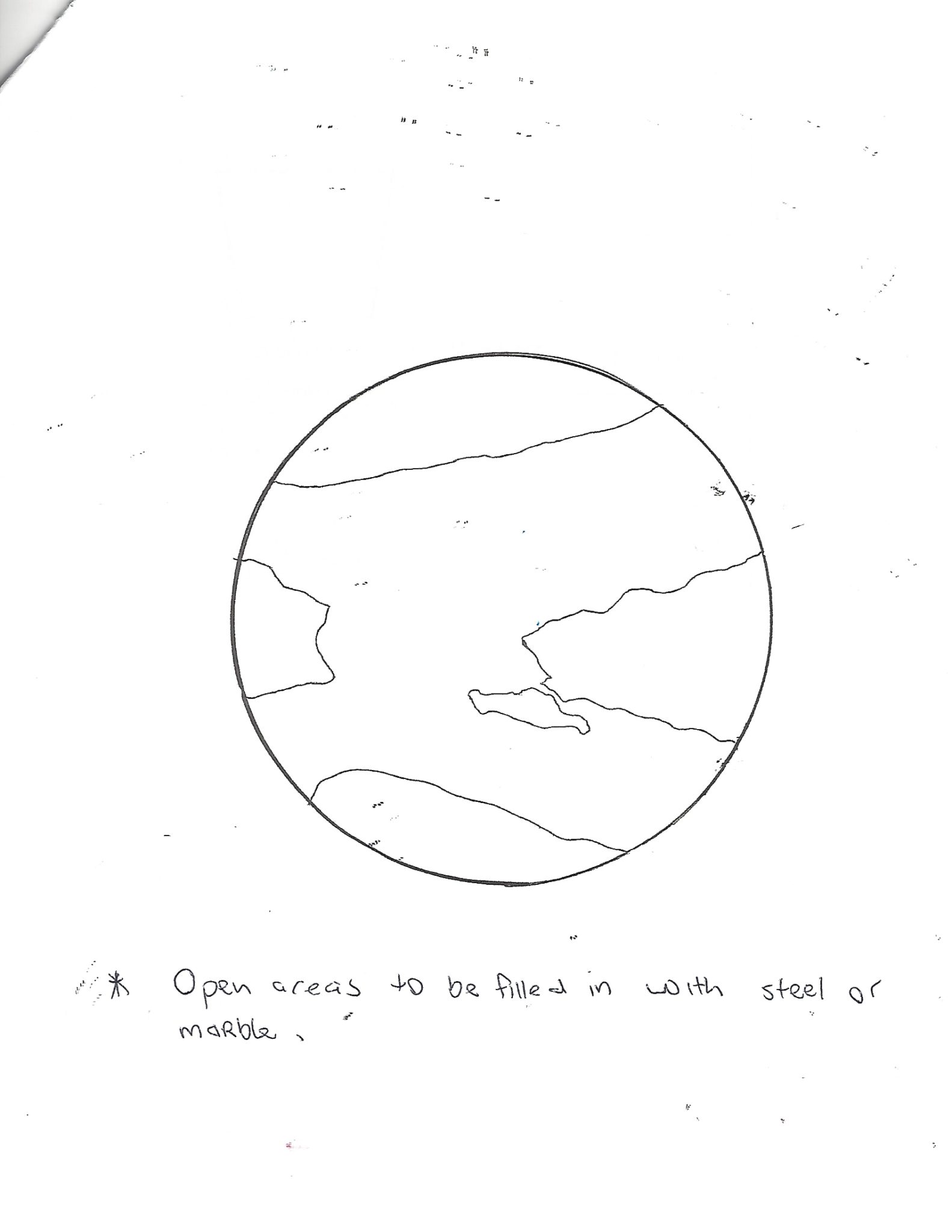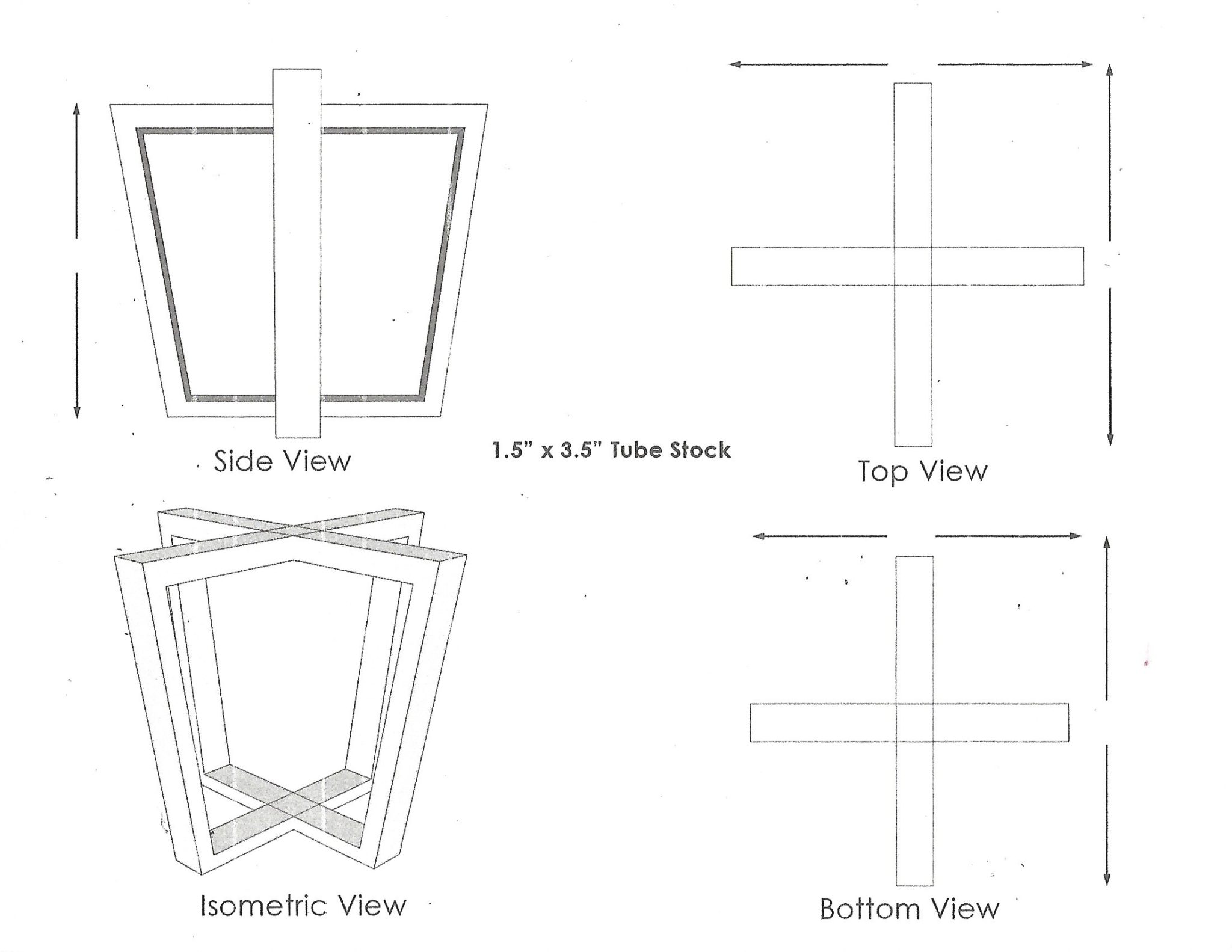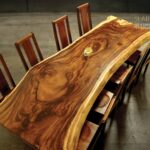Nepal is home to many ethnic groups and religious traditions including Hinduism and Buddhism. Shamanism combines these religions with the worship of nature and natural phenomenon. There is a unique village, called “Lugum”, in Western Nepal whose only inhabitants, at the time of this writing, are 126 shaman – 18 of whom are women. In addition to their role as healers and intermediaries between the mortal and spiritual worlds, is a duty to protect the larger community around them from witches and harmful spirits, whose evil doings wreak havoc if not managed. It is the shaman’s roll to keep everything in balance to maintain the natural order of life. Scroll for images and captions of all the Nepal pieces from our “Balancing The Universe” exhibition. 9/10 – 12/3/17
Damaru with Chopin (2 sided drum with sash), late 19th and early 20th c, Wood, Hide, Fabric
This power drum, associated with Shiva, is used for tantric rituals and is played with a twisting motion so the two beaters – attached by cords, hit the drum heads simultaneously. It produces a rhythmic and spiritual sound by which the universe was created and is regulated. The Chopin (sash) is typically embroidered with the colors of the tantric elements and waves its colors as the drum is played. It is used to attract and dispel negative energy.
(large) 32” x 11 ¼” x 4 ½”; $700.; (small) 2” x 5 ¼” x 3” [case 6” x 5” x 3”] $500. SOLD
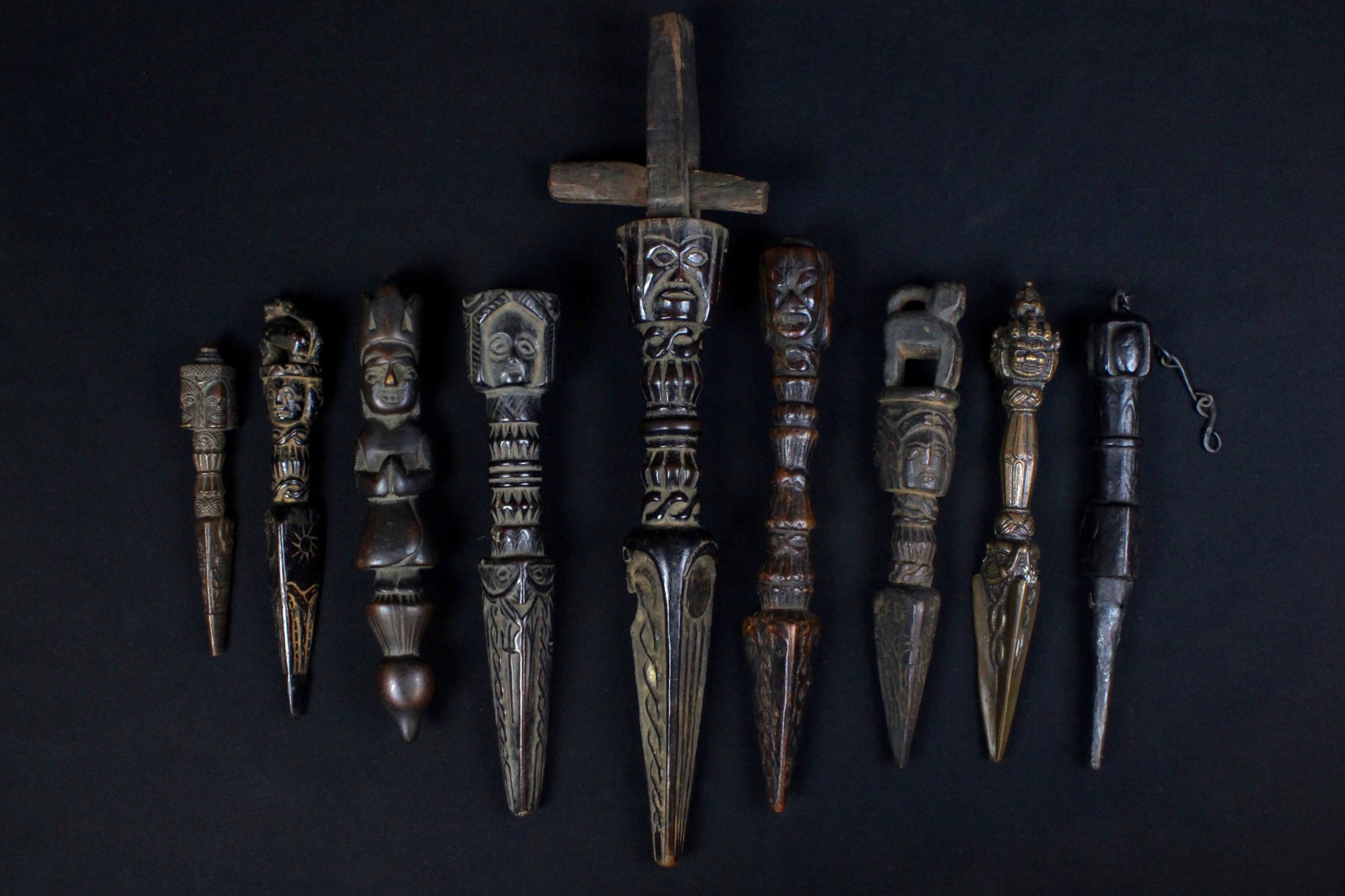
Not meant for stabbing or causing harm to humans, it is used to attract and dispel negative energy. After collecting the demons or evil spirits into the phurba, the shaman pierces the ground with the dagger dispersing or redirecting the harmful energy by releasing them from whatever was causing them to be evil.
Still used by Buddhists and shamans in Nepal, Tibet and the Himalayas, these magical daggers date back to at least the 7th or 8th century. Please see previous ‘Phurba’ blog entry for full history and information on individual pieces – price range is $190. to $650., or contact us for more photos, availability and pricing details.
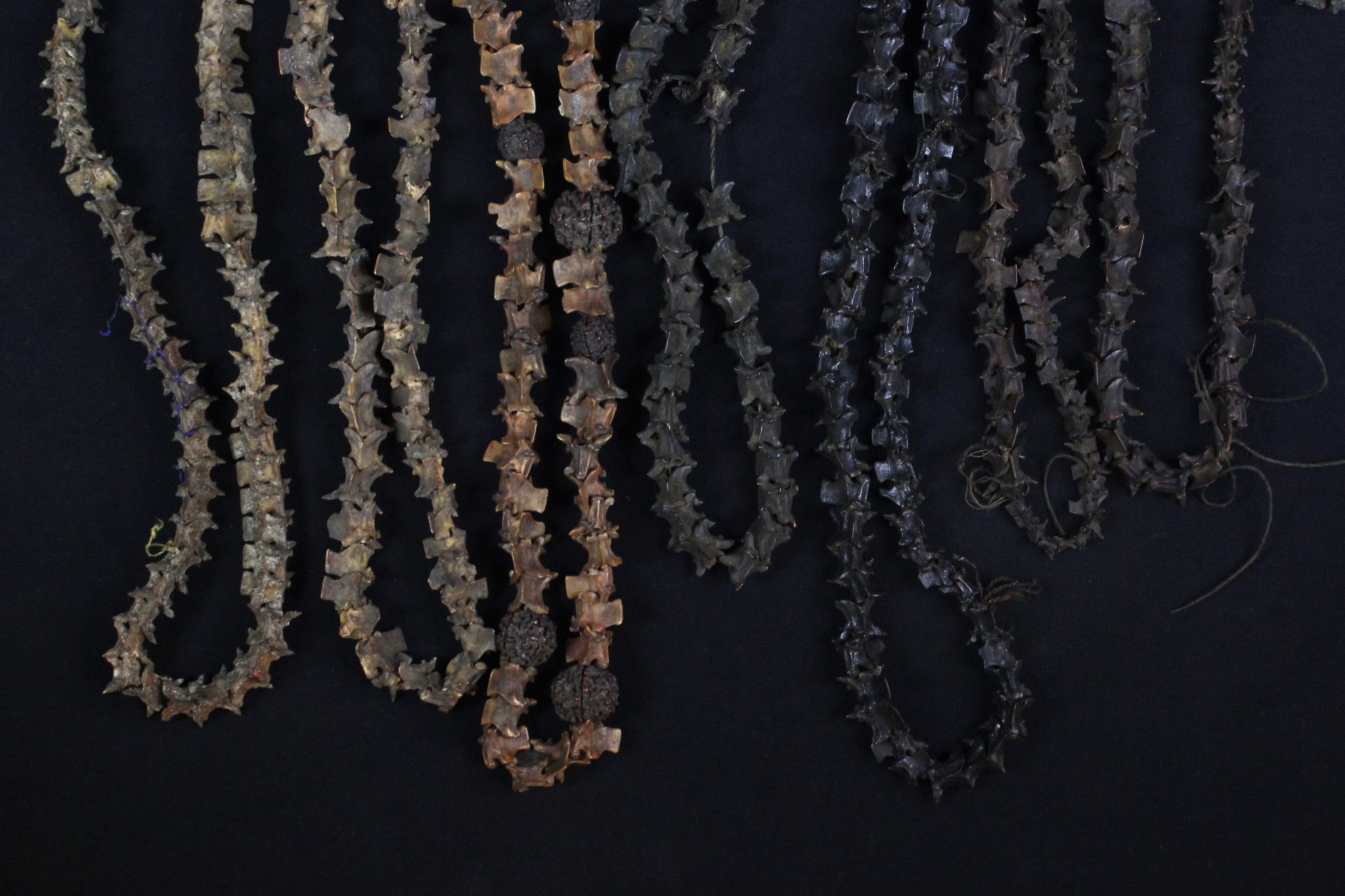
Snake vertebrae prayer bead necklace, worn by shaman to invoke snake gods to protect themselves during healing rituals. From 18″ to 33″; $290 to 370. (see detail image below)
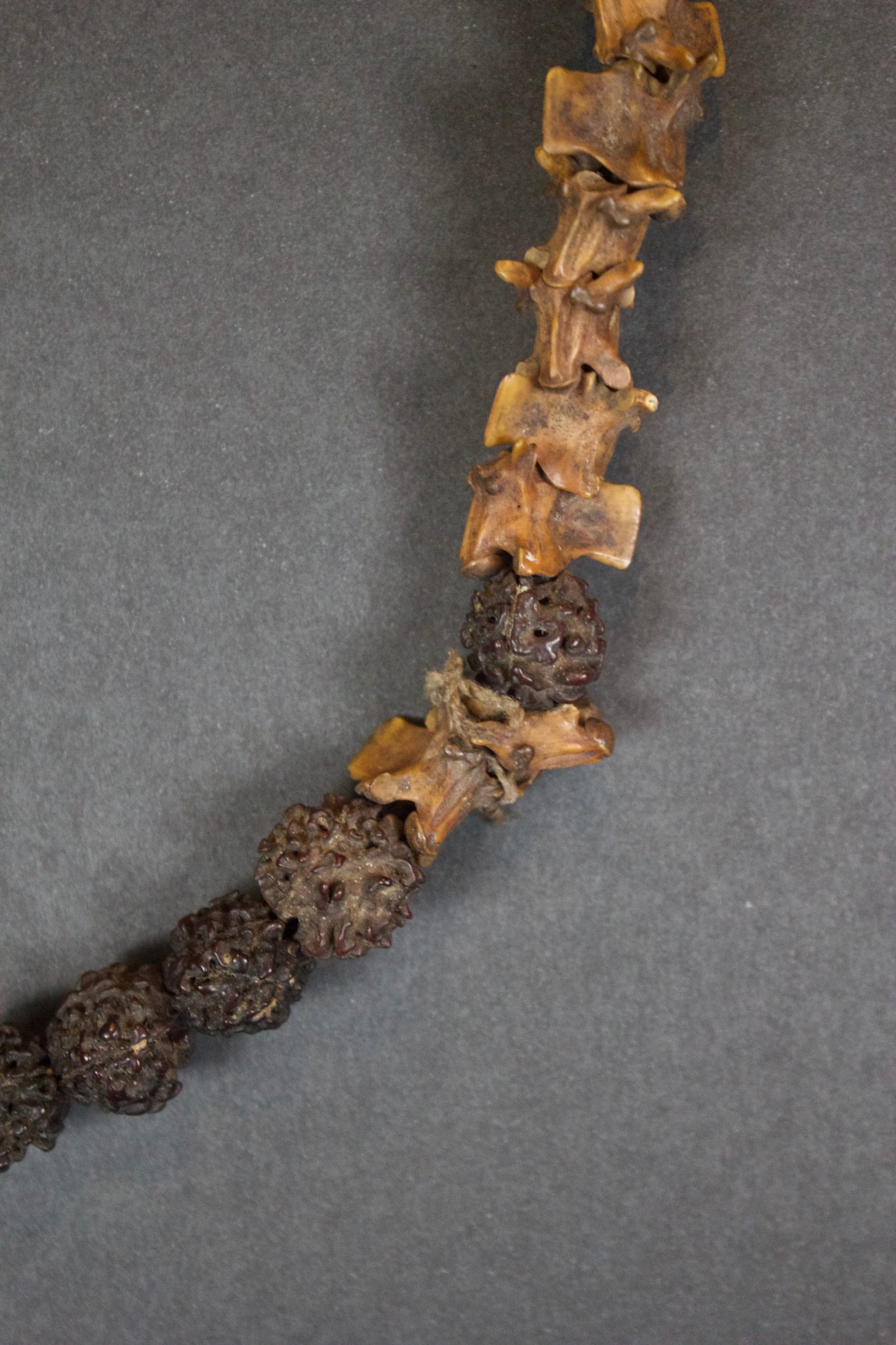
The Naga Mala are primarily used in healing ceremonies for protection against harmful spirits and to connect the shaman with the sacred snake gods and goddesses who help inform their work. The preparation of the snake bones, and of creating the necklace itself, involves an intricate sacred ritual to properly empower them. Rudraksha, meaning ‘Enlightened’, seeds symbolize divine wisdom and are traditionally used as prayer beads.
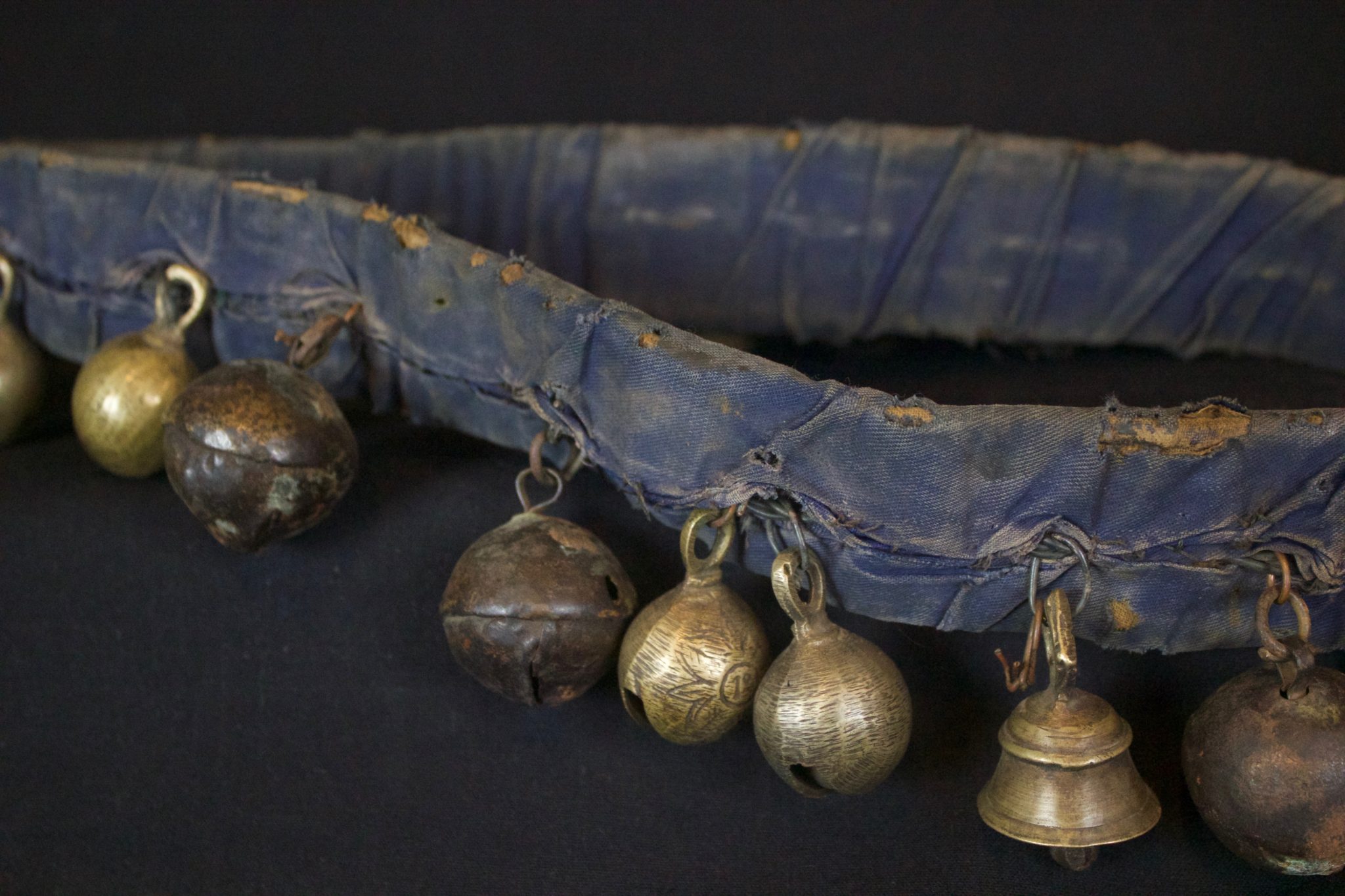
Worn over the head piece and under the chin to secure the shaman’s ‘hat’; Indigo dyed cotton cloth covering a woven fiber band with attached conical and crotal bells. Used in healing rituals and to protect the shaman and the villagers from witches and other evil beings. Some of the bells are newer case brass, some are old hand forged iron.
18 ⅓” x 4 ½” x 1 ⅗”; $395.
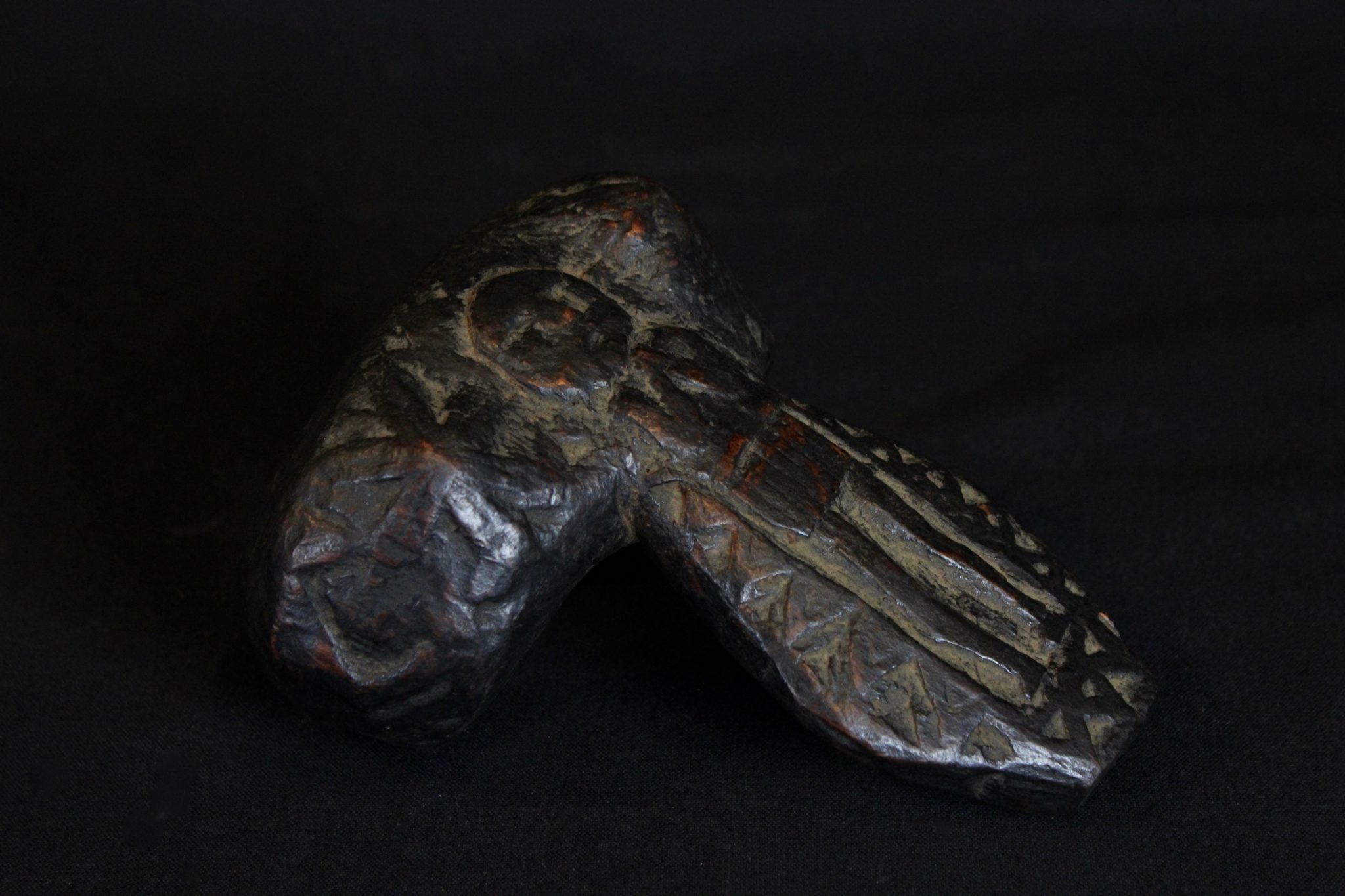
Worn by shaman during rituals and ceremonies to protect themselves from witches and harmful spirits. Hand carved wood, 3 ¼” x 4 ¼” x 5 ¼”, $120. SOLD
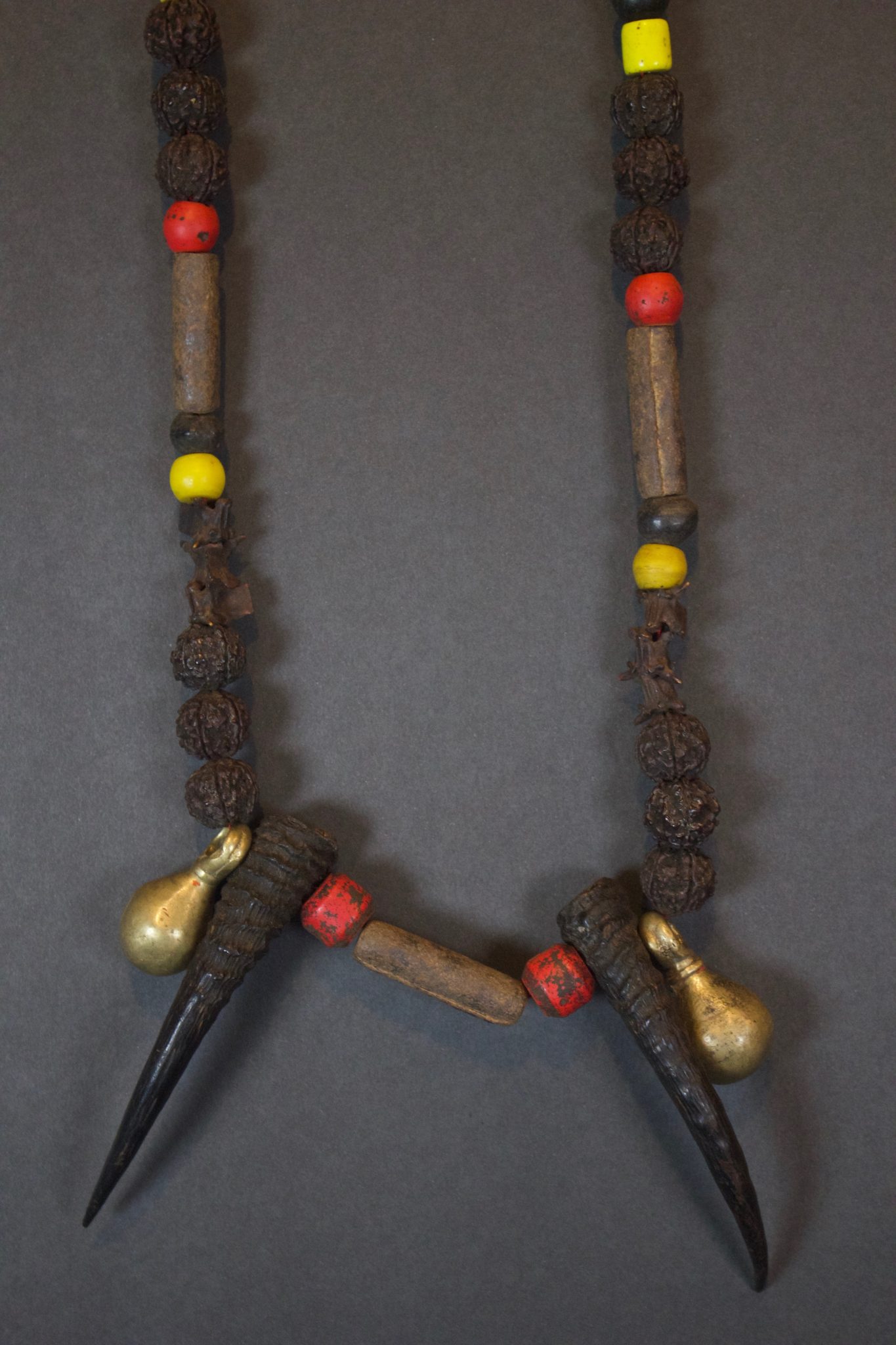
The Naga Mala are primarily used in healing ceremonies for protection and to connect the shaman with the sacred snake gods and goddesses who help inform their work. The preparation of the snake bones and of the necklace itself, involves an intricate sacred ritual to properly empower them. The Rudraksha (enlightened) seeds symbolize divine wisdom and are traditionally used as prayer beads. The bells make a sound that evoke ancestor spirits and helps the shaman transition into a trance state for ceremonies., 22” x 7” x 1 ¾”, $750.
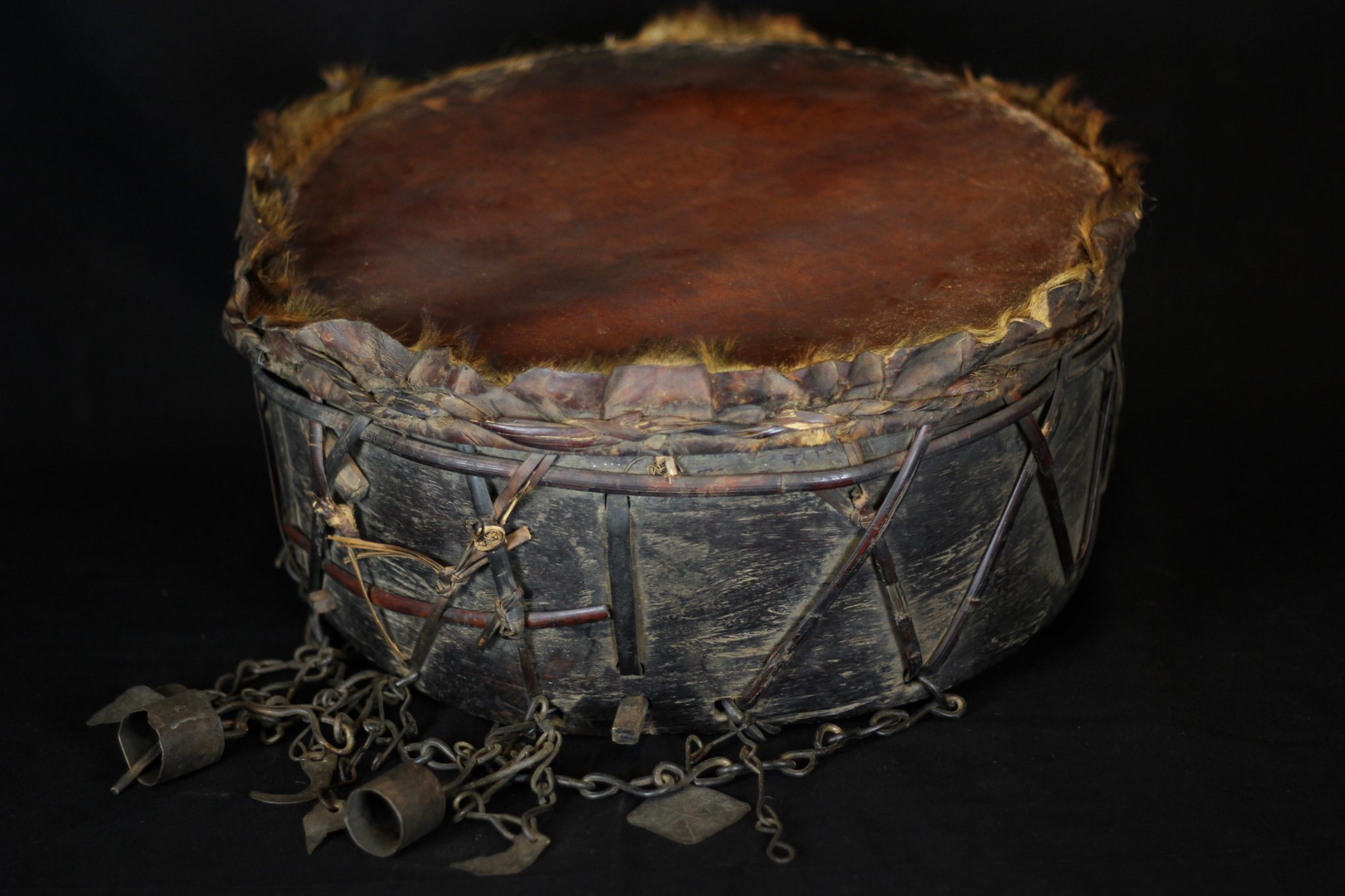
The Yak bells and amulets facilitate entering and maintaining a trance state necessary for the shaman to perform rituals, 17 ½” x 8” x 8” (plus 7” bell chains), $1400.
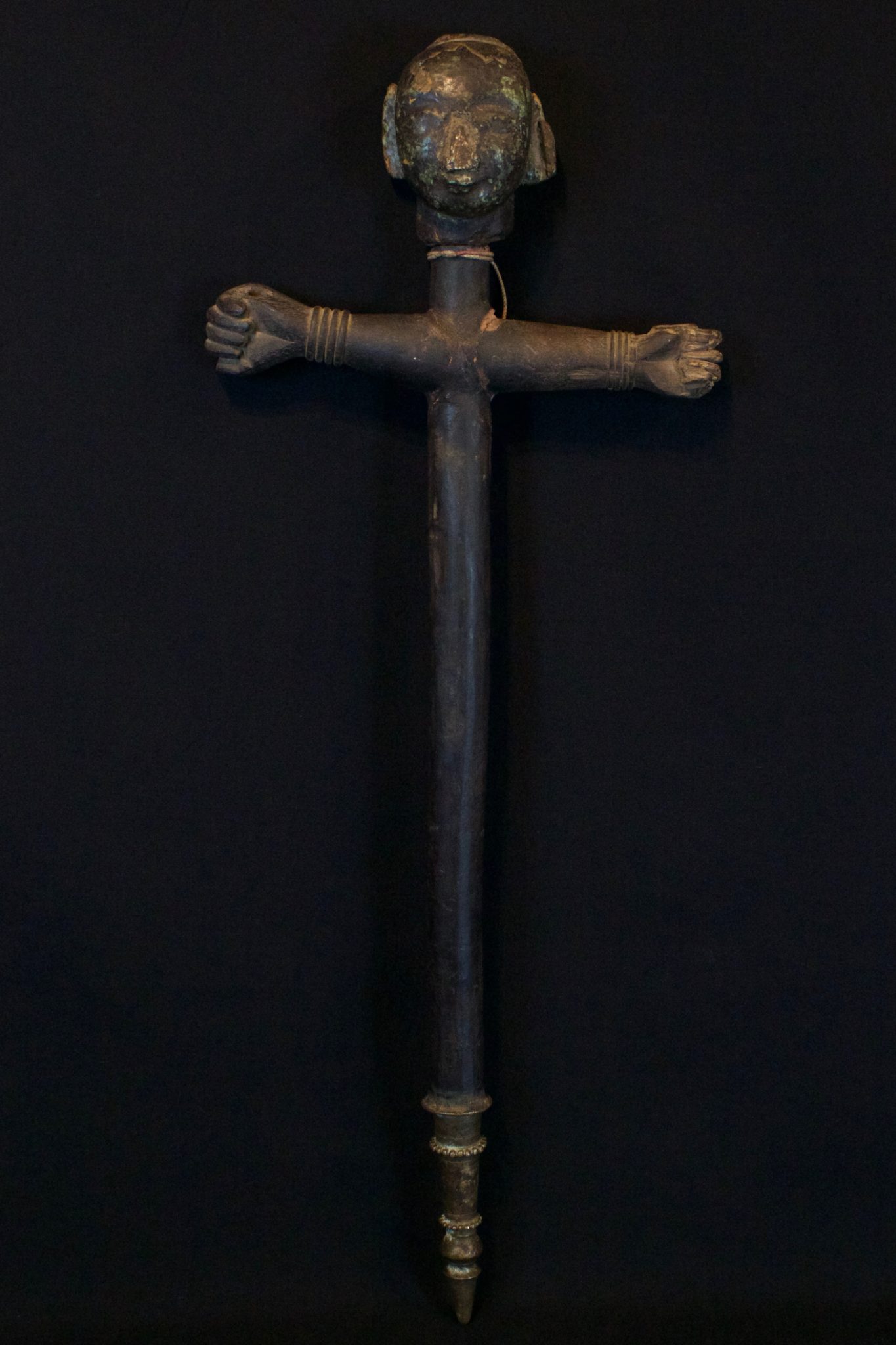
This Wand from Northwestern Nepal (near Lake Jumla) is a powerful shaman tool. Held in one hand while chanting, the shaman shakes it with short, quick jerks then taps it to the ground to cleanse the area from harmful spirits.
28” x 11” x 3 ¼”, $650. SOLD
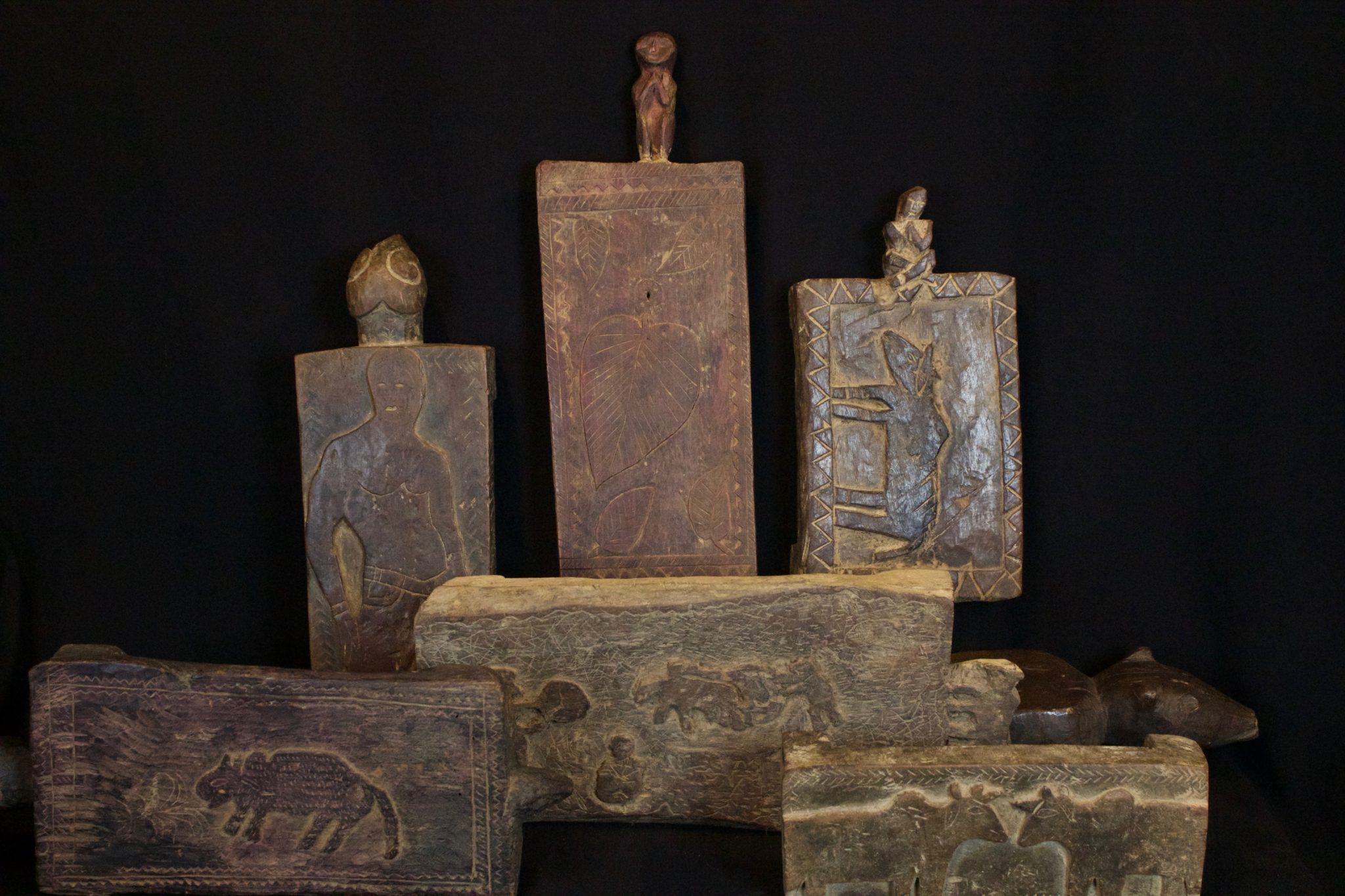
Hand carved wood. They are used to sit slightly elevated off the ground for meditation and for ritual ceremonies.
12″ to 14″, $185. to $320.
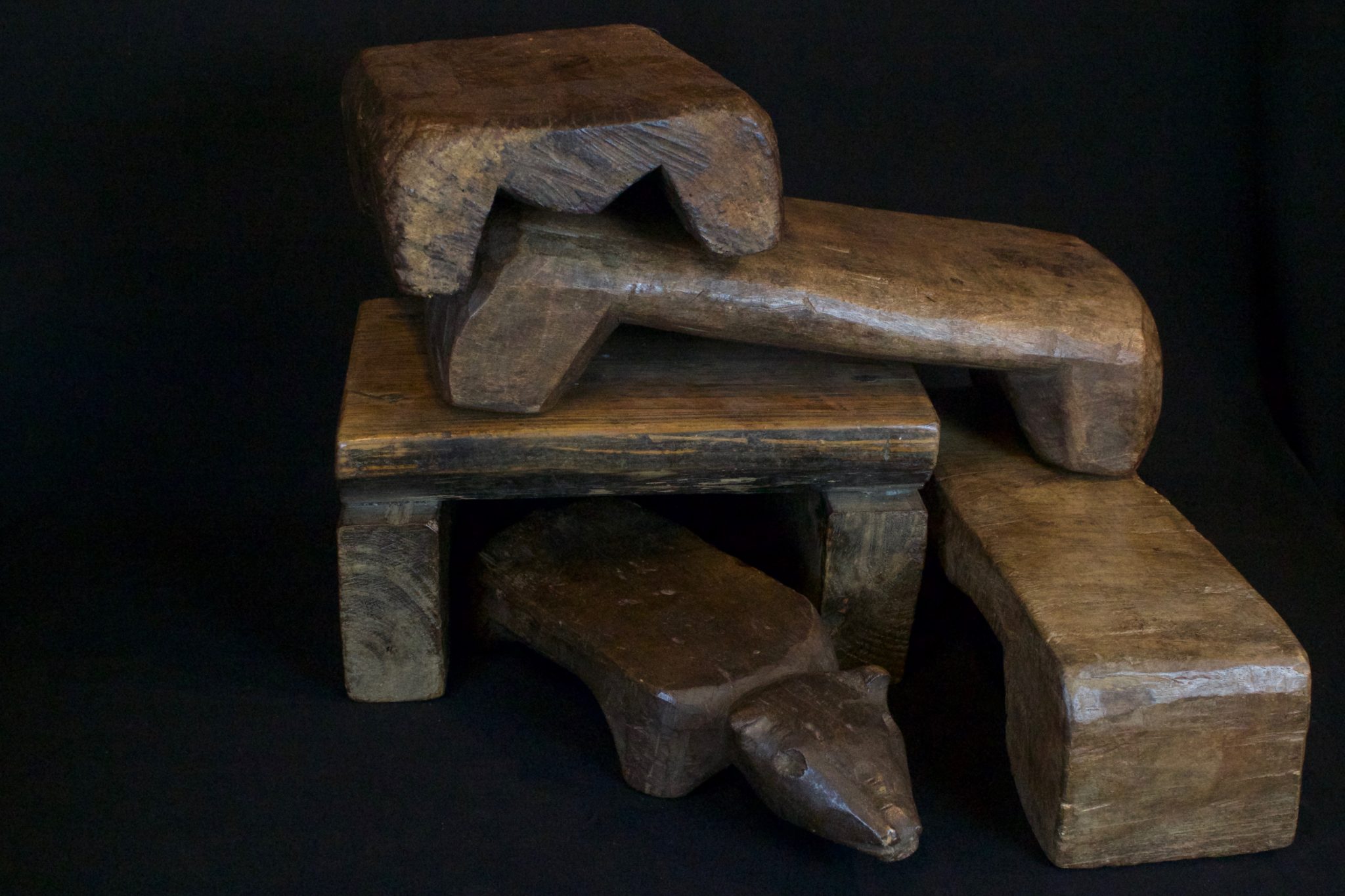
Hand Carved Wooden Ceremonial Shaman Stools. They are used to sit slightly elevated off the ground for meditation and for ritual ceremonies, Mid 19th to early 20th century, 8″ to 14″, $95. to $190.
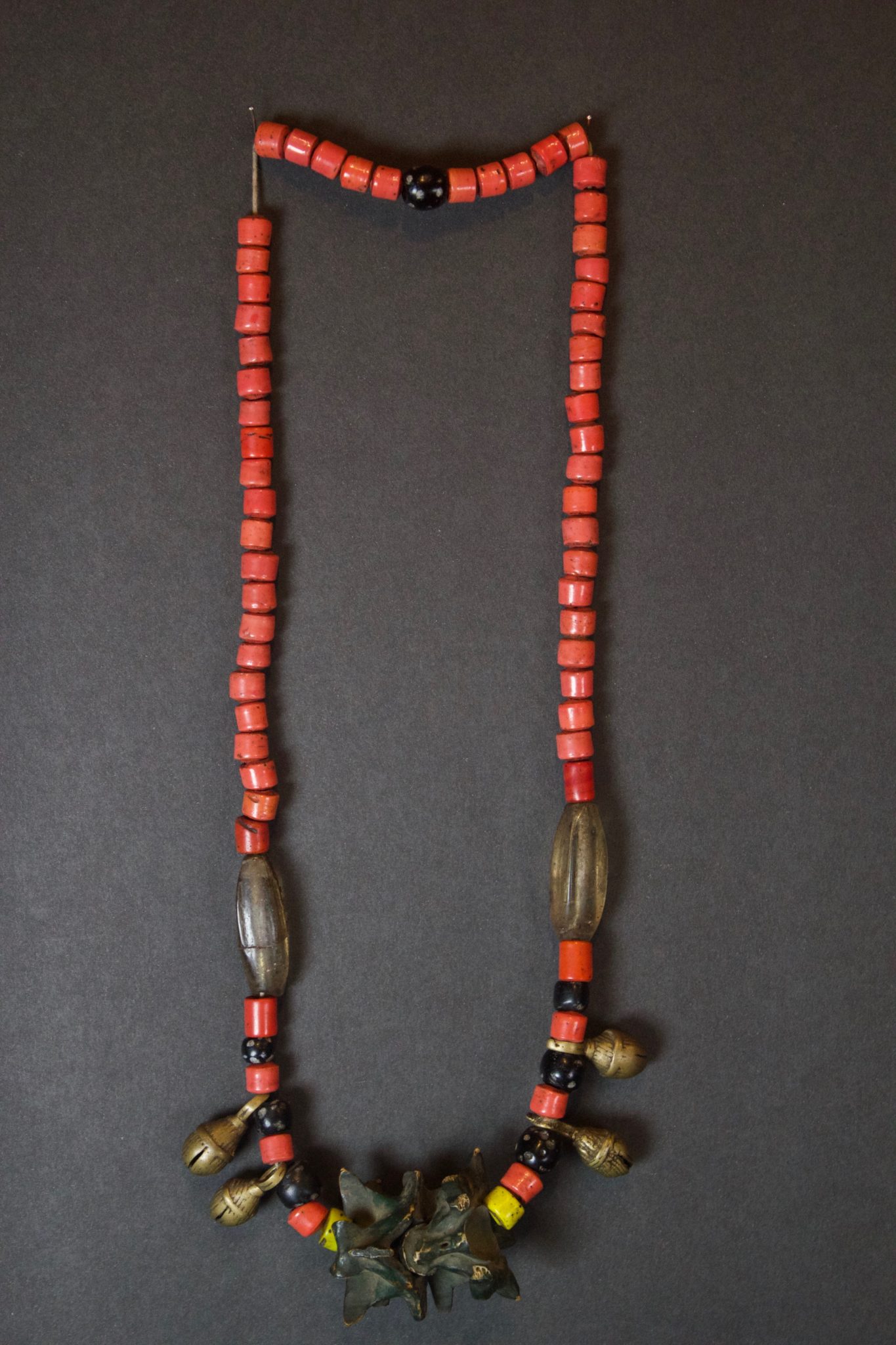
This sacred shaman necklace is particularly rare because of the size of the snake vertebrae used. It is colorfully detailed with the old European handmade glass trade beads and old clear quartz beads, and the age and use worn small brass crotal bells. The pair of unusually large snake vertebrae are from a 20 foot anaconda. They have been painted green. The preparation of the snake bones and the necklace itself involves an intricate sacred ritual to properly empower them. The bell sound helps the shaman transition into a trance state in preparation for a ceremony and the snake bone connects them to ancestral spirits. 13” x 3 ¾” 1 ½”, $875. SOLD
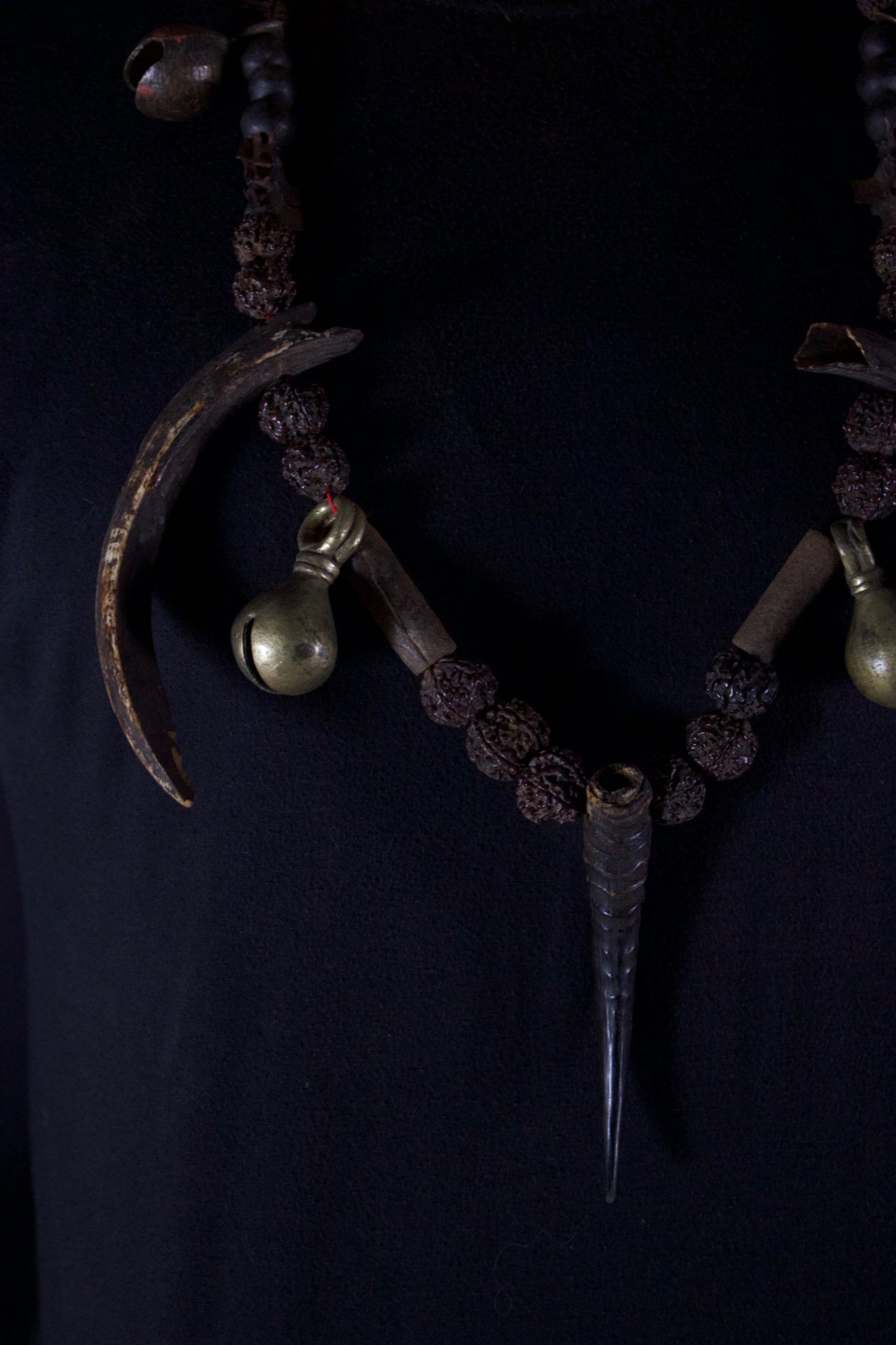
The Naga Mala, primarily used in healing ceremonies, are for the shaman’s protection and to connect them with the snake gods and goddesses who help inform their work. The preparation of the snake bones and the necklace itself involve an intricate sacred ritual to properly empower them., The Rudraksha, meaning ‘enlightened’, seeds symbolize divine wisdom and are traditionally used as prayer beads. 22” x 7 ½” x 1 ¼”, $690.
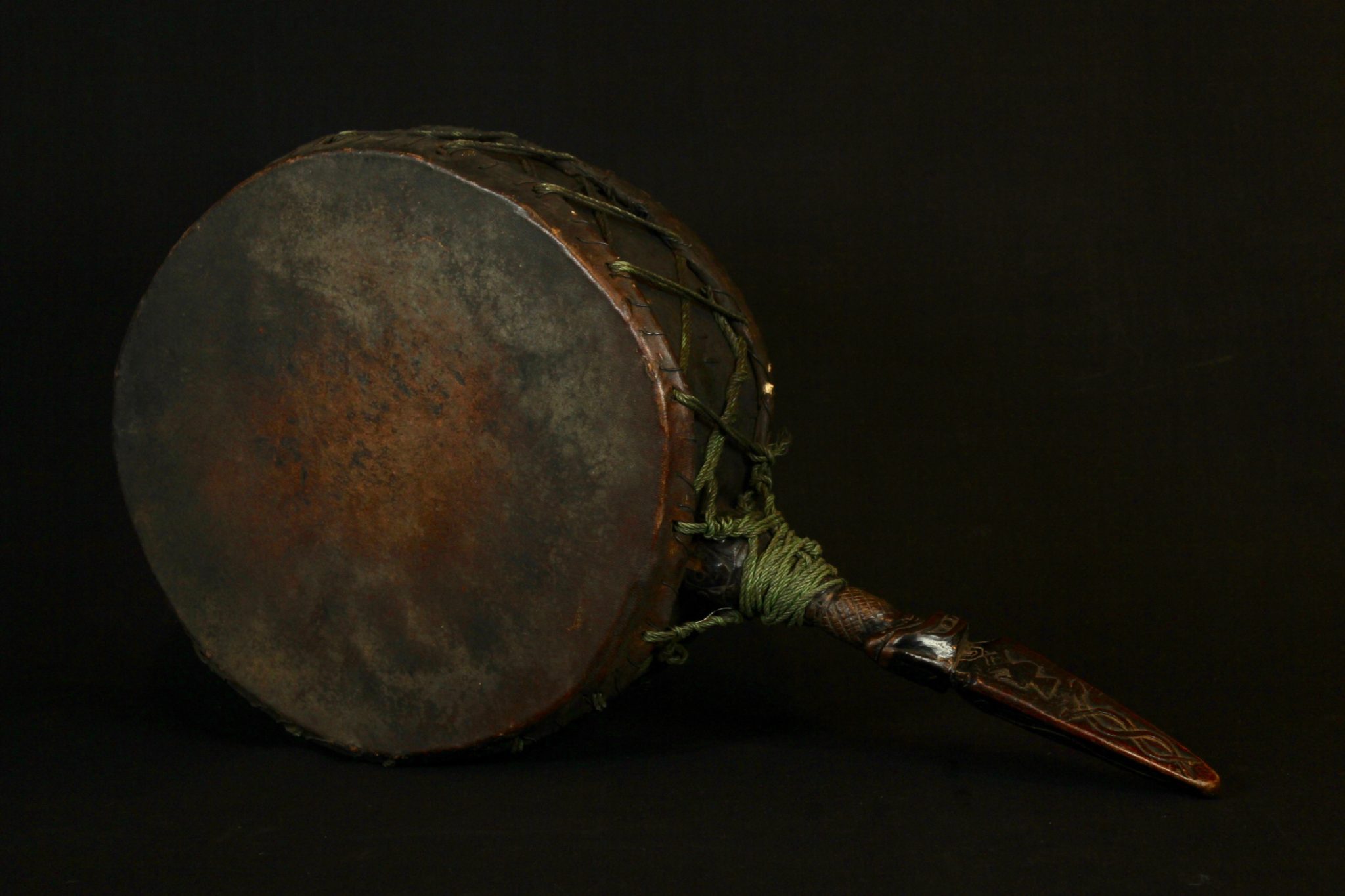
Played by shaman (Jhakri), with a curved stick, to facilitate entering and maintaining the shaman’s trance state for their journey into the spirit world. A deity will often reside in the drum during the ritual. 26″ x 14″ x 6′, $900.
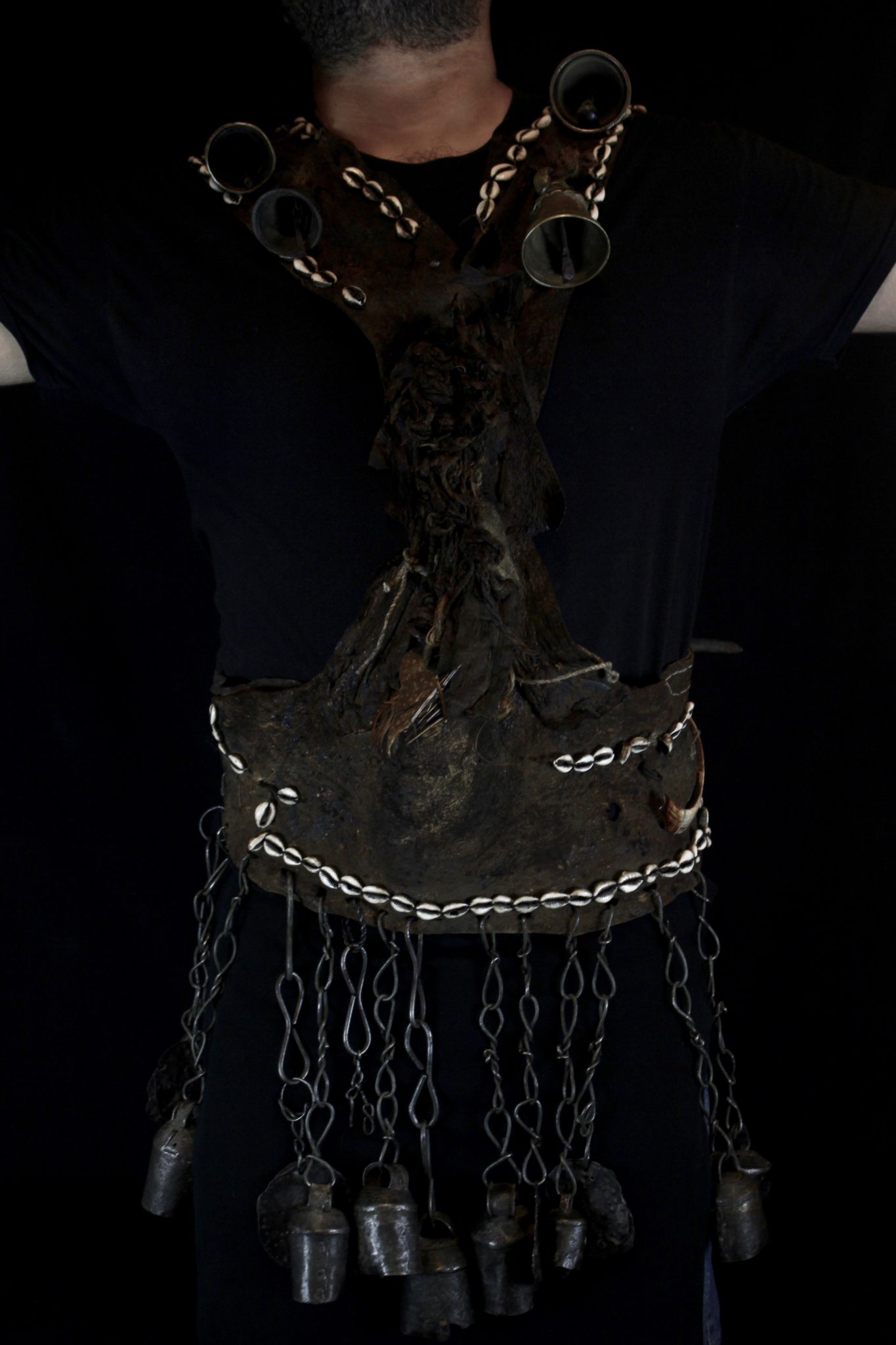
This large belt is an essential part of all Nepalese shaman costumes. The belt, or apron, is heavy and loud with the many parts: hide leather, iron chain and hand crafted crotal, and cylindrical bells and bangles, and the brass conical bells. The cowrie shells, goat horn and wild boar tusk are all symbolic and spiritual tools. They are used in rituals to protect shaman, villagers and the area from witches and other evil beings. (it is a waist belt with hanging bells and over the shoulder cross straps). 58” x 32” x 3”, $3200.
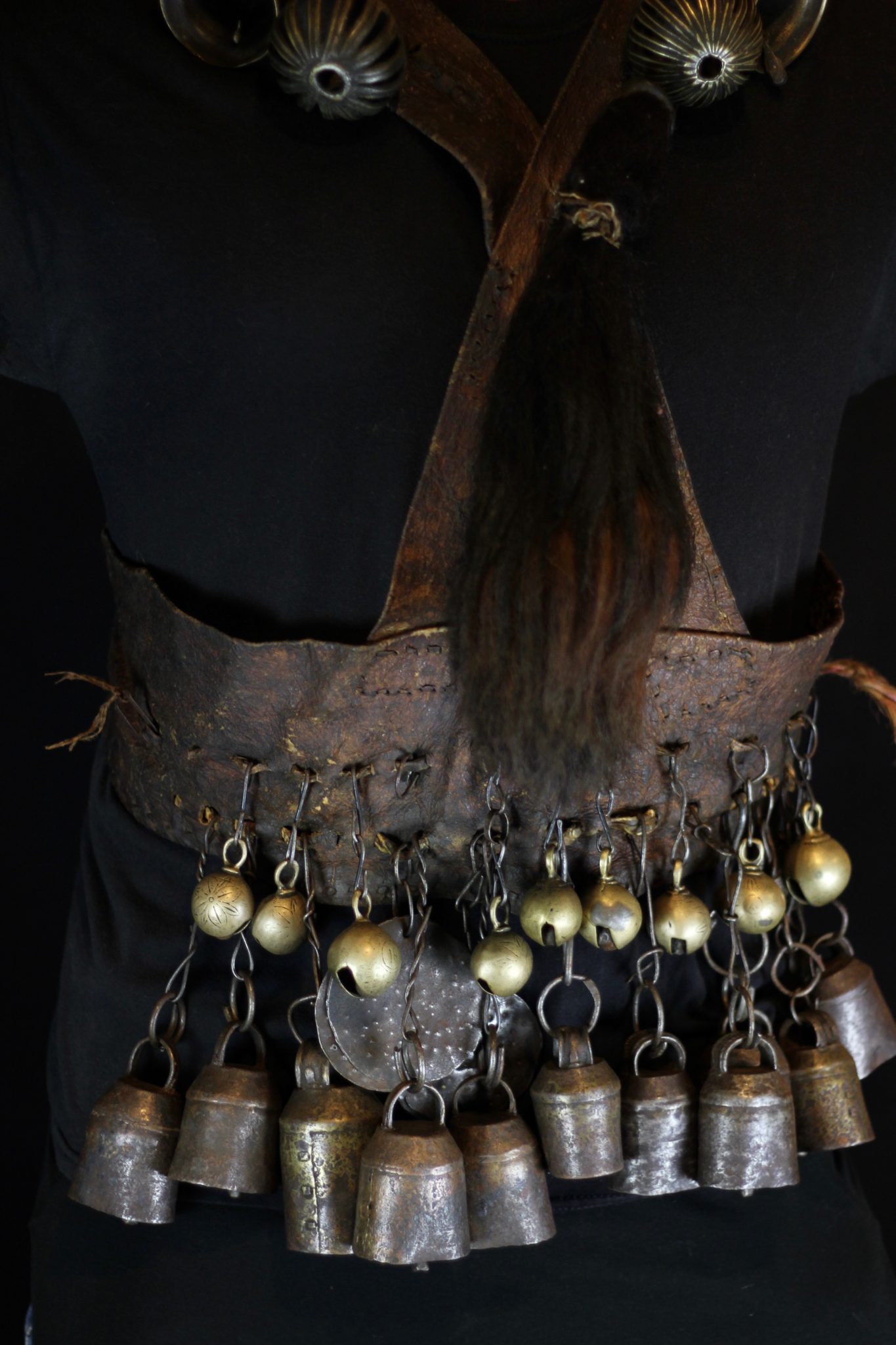
An essential part of Nepalese shaman costumes, this heavy apron belt is made of hide leather, iron chain and hand crafted cylindrical bells and bangles, brass conical and crotal bells. The yak tail, and other amulets which are attached, are powerful spiritual tools. They are worn during rituals and ceremonies to protect the shaman, the villagers, and the area from witches and other evil beings. (it is a waist belt with hanging bells and over the shoulder cross straps), 44” x 33” x 3”, $3200.
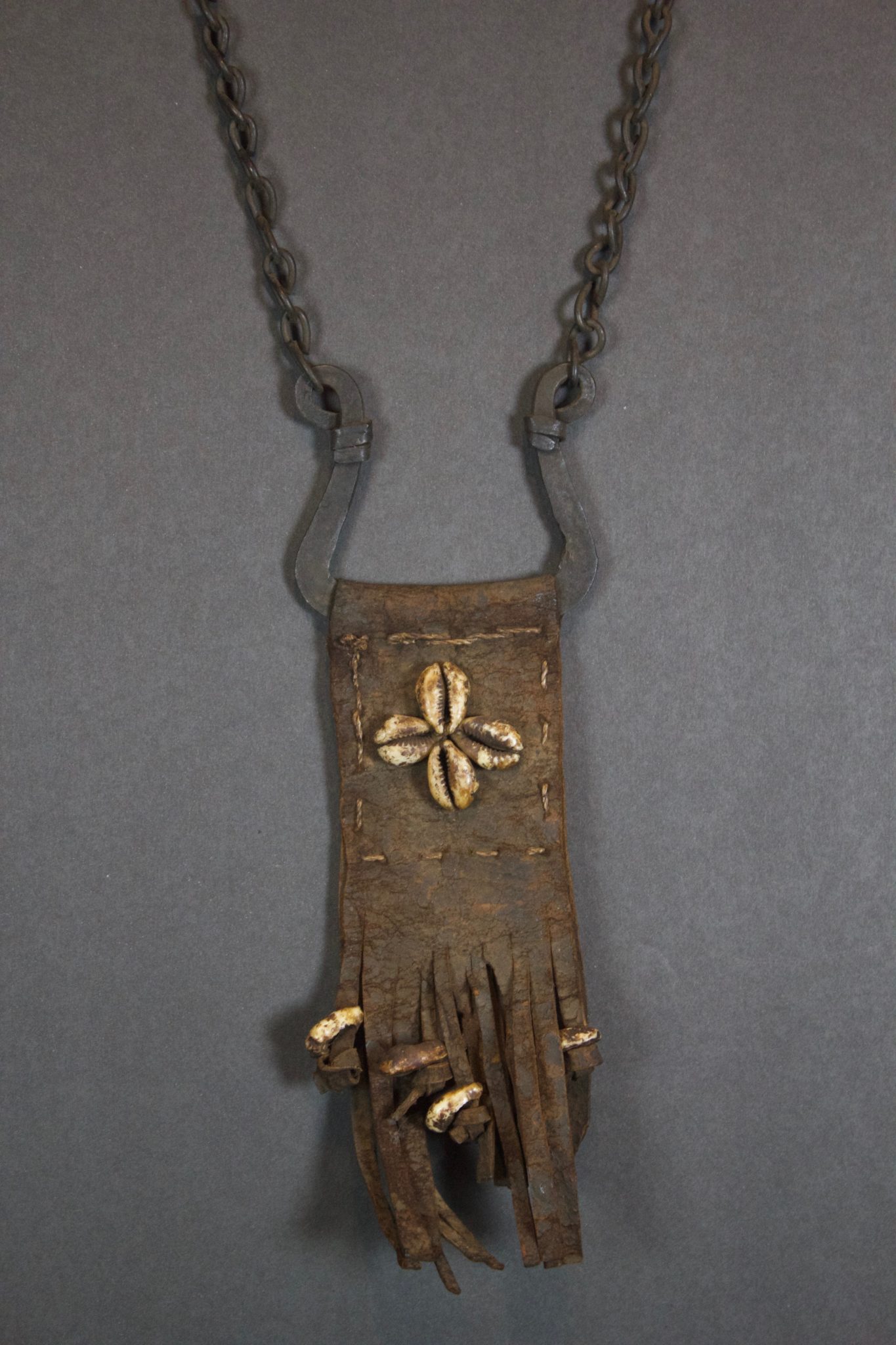
This leather amulet with the four cowrie shells and brass conical bells on a chain, is a sacred ritual necklace is worn to facilitate entering a trance state. The bells make a nice sound when worn or hung in the wind, that represents a caravan of yaks coming down a mountain, creating a magical link to their ancestors who migrated over the Himalayas from Tibet to Nepal, 28 ½” x 3 ¼” x 1”, $295.
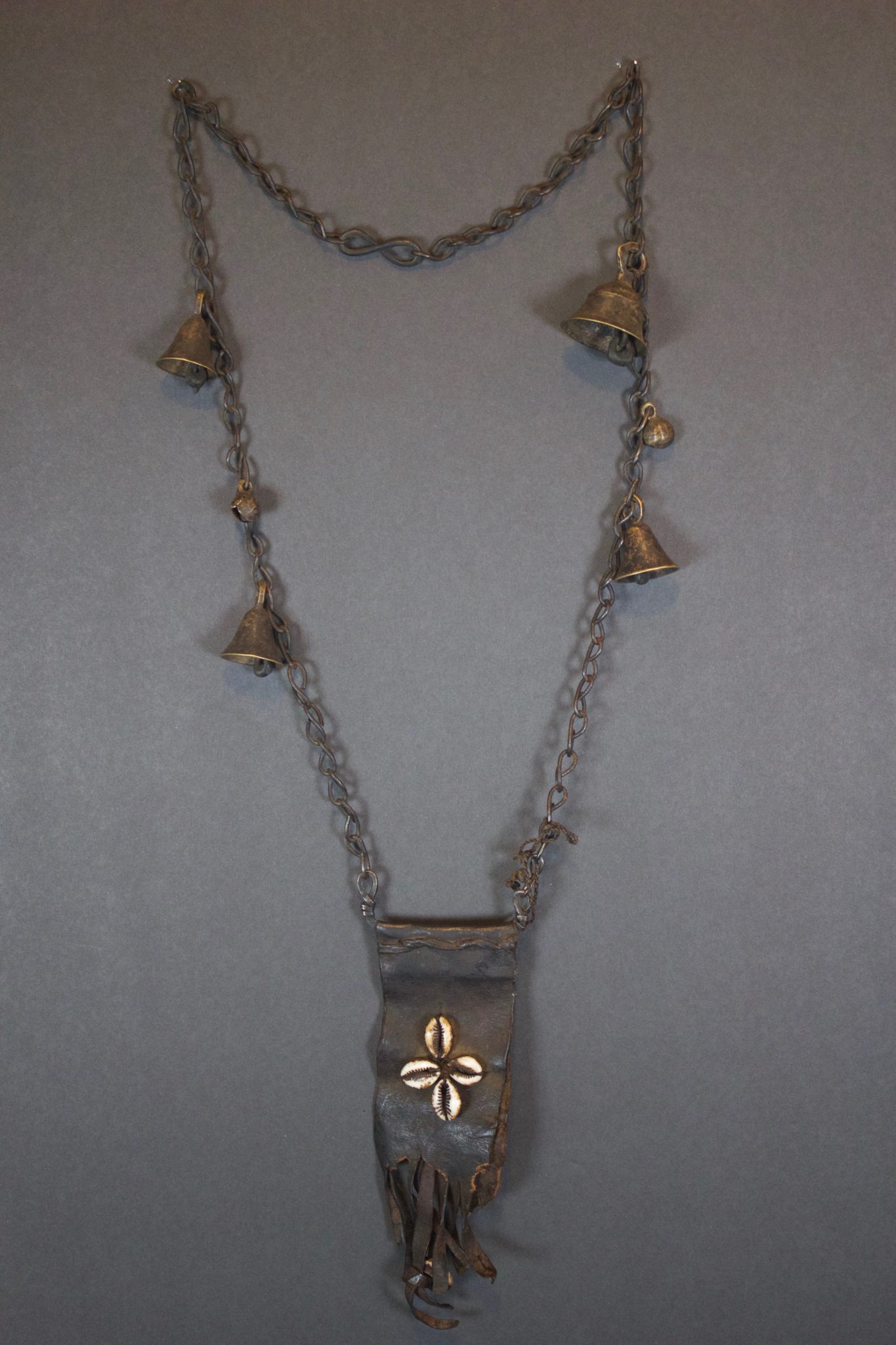
This leather amulet with the four cowrie shells and brass conical bells on a chain, is a sacred ritual necklace is worn to facilitate entering a trance state. The bells make a nice sound when worn or hung in the wind, that represents a caravan of yaks coming down a mountain, creating a magical link to their ancestors who migrated over the Himalayas from Tibet to Nepal, 28 ½” x 3 ¼” x 1”,$295.
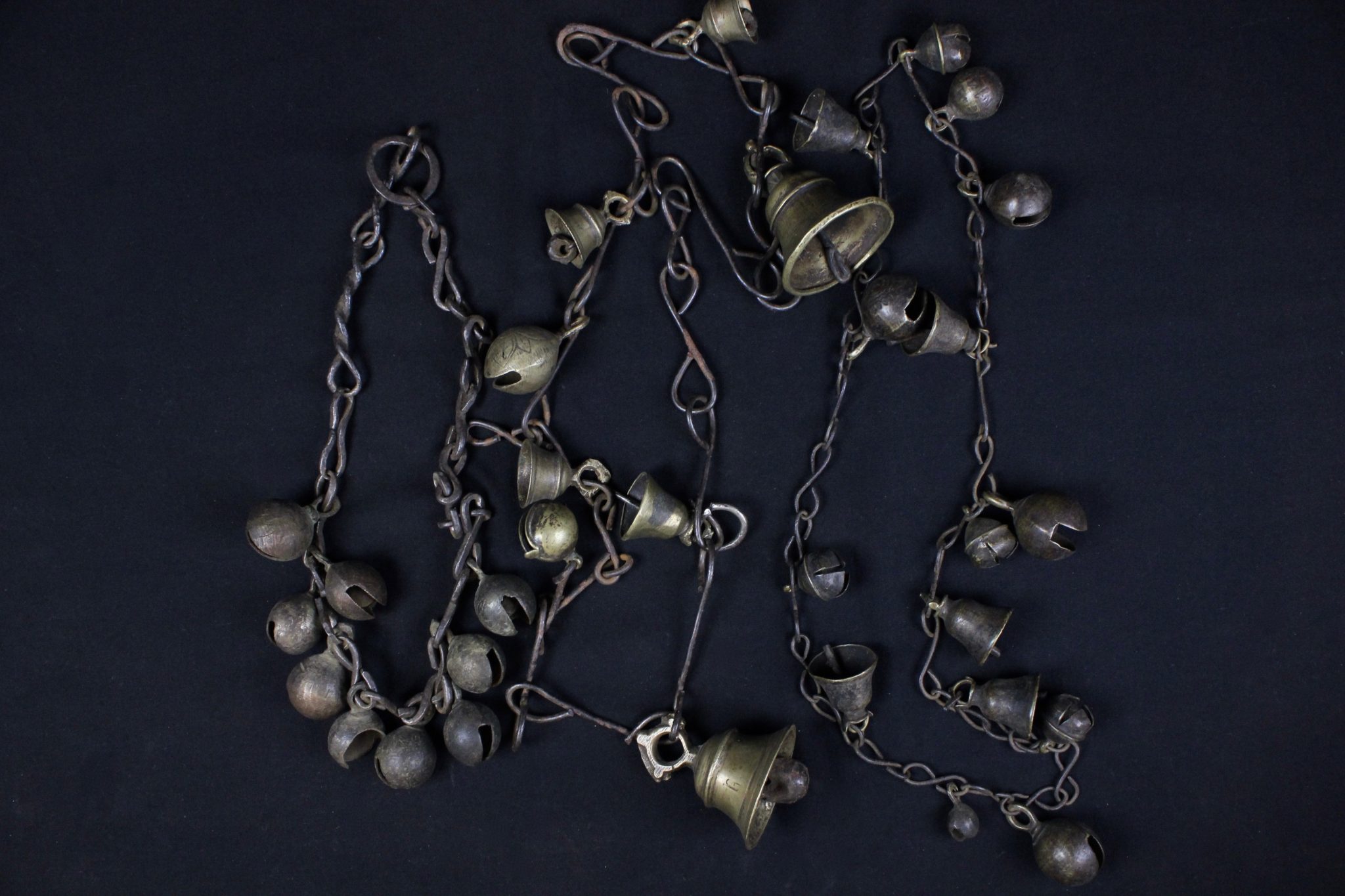
Shaman wear loud bells to facilitate entering a trance state necessary for their practice. Makes a nice sound when worn or hung in the wind, that represents a caravan of yaks coming down a mountain, creating a magical link to their ancestors who migrated over the Himalayas from Tibet to Nepal, 15″ to 21″, $230. to 290. SOLD
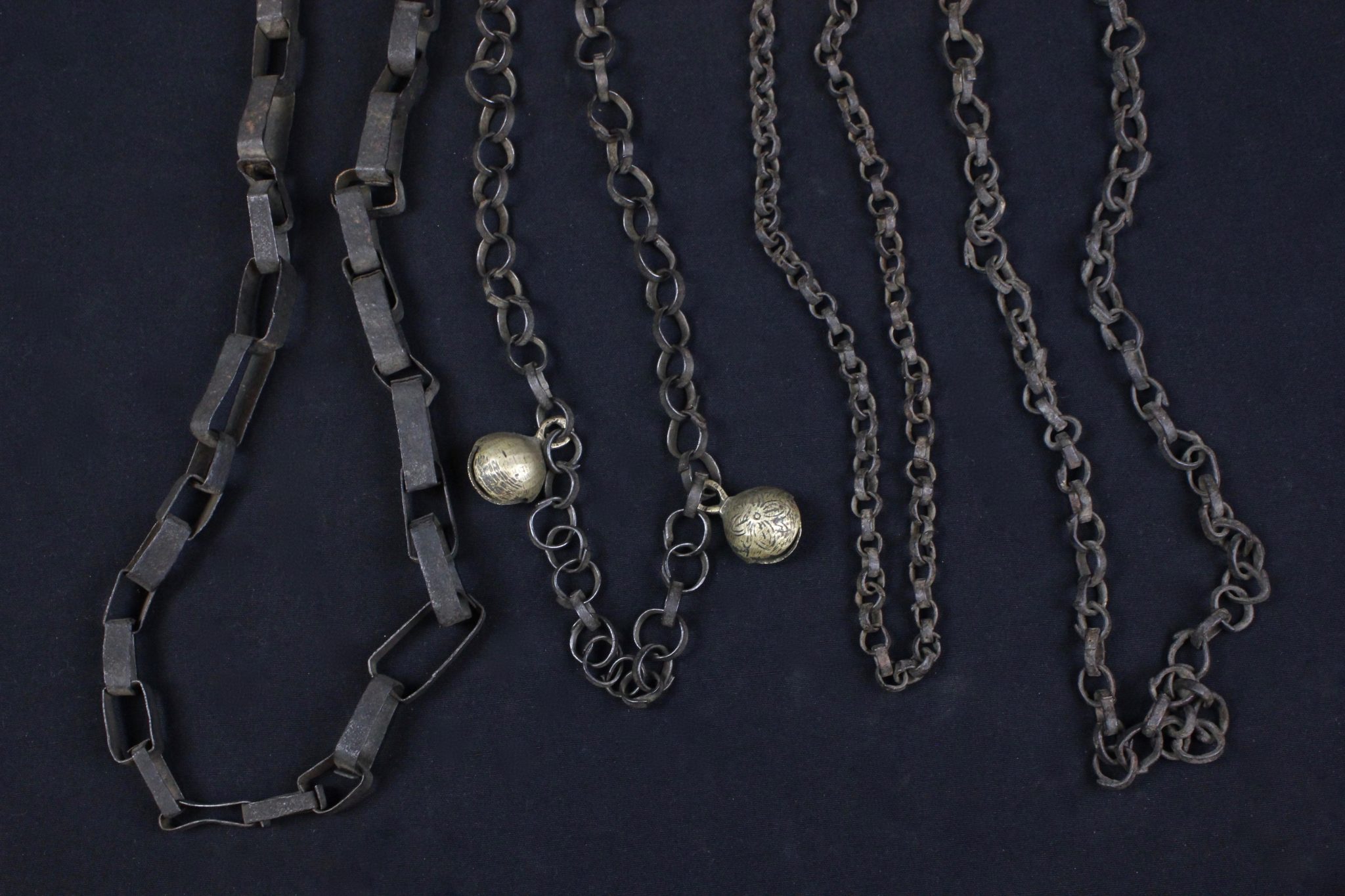
Part of the shaman’s costume worn during rituals and ceremonies to protect them from witches and harmful spirits. Bells and amulets are often attached to the chain. 15″ to 21″, $110. to $130.

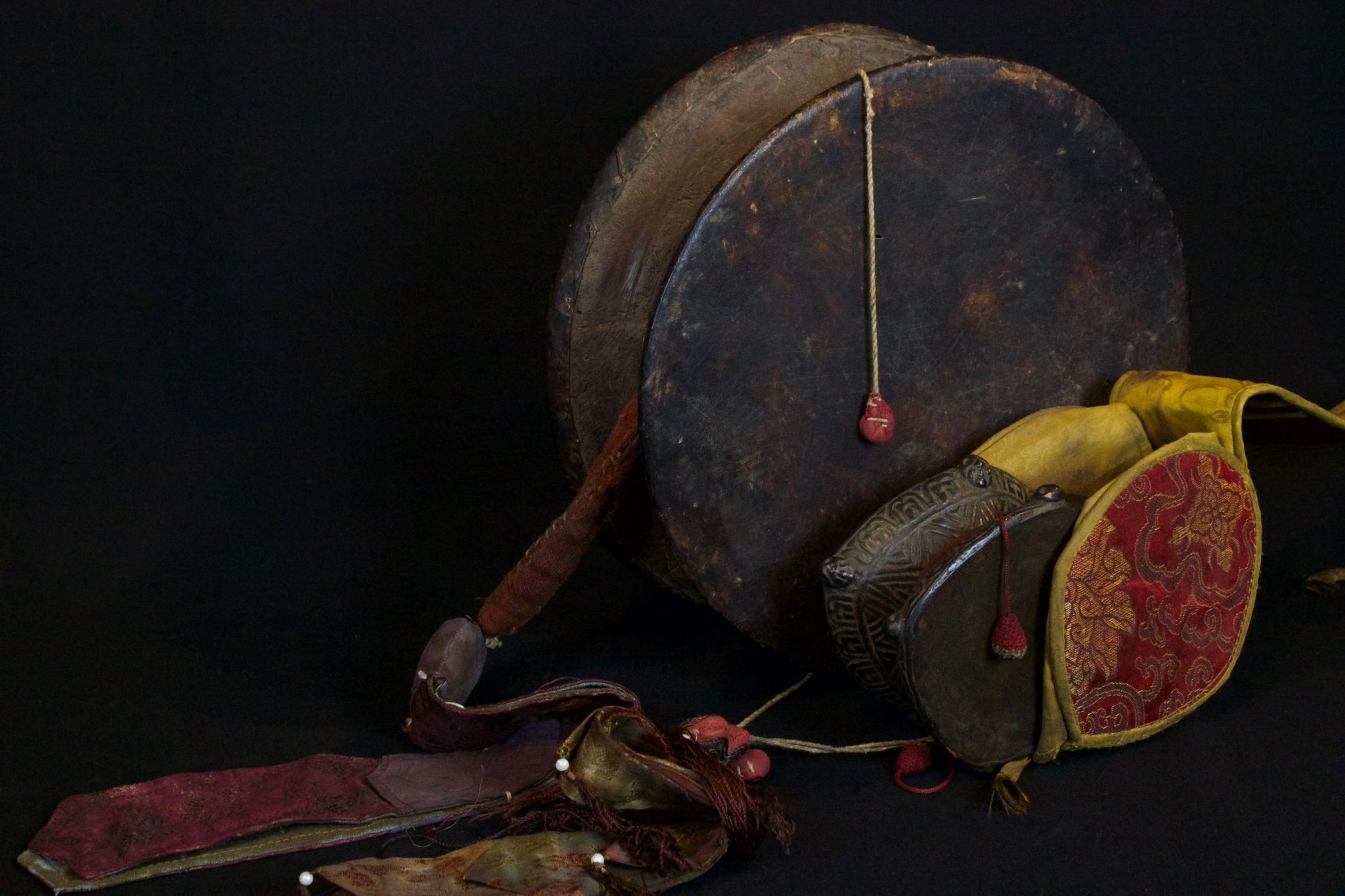
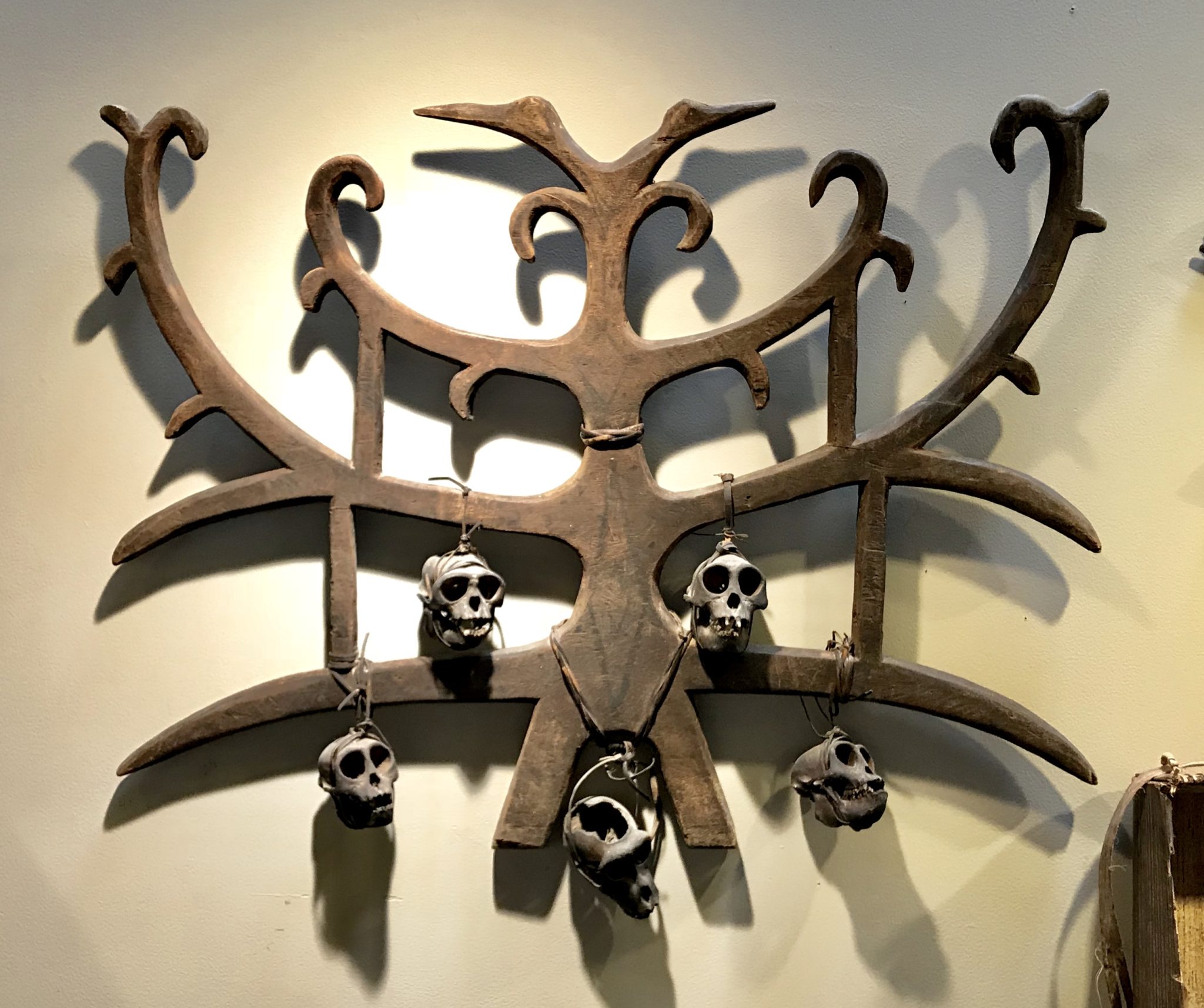
 It took months to research the individual pieces that represent many different, ancient healing cultures from South East Asia – Nepal, Vietnam, Thailand, Myanmar, Nagaland (India) and across the 17,000 Islands of Indonesia. Some of the pieces have been passed down through generations of healers and date back 400 years. Please inquire for a tour of the magical mystery pieces! If you have the time to browse, we learned a lot and would love to share all the intriguing histories.
It took months to research the individual pieces that represent many different, ancient healing cultures from South East Asia – Nepal, Vietnam, Thailand, Myanmar, Nagaland (India) and across the 17,000 Islands of Indonesia. Some of the pieces have been passed down through generations of healers and date back 400 years. Please inquire for a tour of the magical mystery pieces! If you have the time to browse, we learned a lot and would love to share all the intriguing histories.